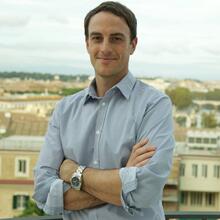On the surface, there’s nothing backward about the Synod on Synodality. Pope Francis has persistently called the church to press on, to keep moving forward with courage and hope down the synodal path, and not to remain static. The sense among many synod delegates at this stage of the journey is that there’s no going back.
But sometimes you have to go backward to go forward. One of the greatest inspirations of the Second Vatican Council was ressourcement—tapping into the sources of revelation and the church’s tradition to retrieve the essential dynamism of the Gospel for a new epoch. That retrieval, which, if approached honestly and faithfully, always disrupts, challenges and inspires the church. That retrieval often brings forth something new. In other words, it goes back to bring the church forward.
An important reference for grappling with this paradox is Pope Benedict XVI’s Christmas address to the Roman Curia in 2005, in which he described two “hermeneutics” for interpreting the council: one of “discontinuity and rupture” and one of “reform.” (He believed the latter to be the correct approach.) Benedict was a young theologian during Vatican II and helped shape and implement the council. For the rest of his life and ministry in the church, he would be a torchbearer for the council’s decrees, while remaining critical of those who, in his view, used the council’s impulse for renewal to move beyond the texts and imagine a new church devoid of antiquated references and traditions. He saw the 16 documents of the council as a unique expression of ressourcement, which, as he said toward the end of his pontificate in 2012, “saves us from extremes of anachronistic nostalgia and running too far ahead, and allows what is new to be welcomed in a context of continuity.”
What gave the documents credibility in Benedict’s mind and heart was their firm foundation in the eternal revolution of the incarnation. Because the council had “gone back” to Gospel truth to reimagine the church for a new epoch, we can all confidently go back to the documents of the council. Going back in order to go forward.
For me, perhaps the greatest takeaway from this second session of the synod is how intentionally rooted it is in the Second Vatican Council, both in its impulse toward renewal and in the documents themselves. As I wrote earlier this month, “practically every public-facing event of this synod has referenced, quoted and developed ideas from the council.” There is a kind of ressourcement of the council happening here that shouldn’t go unnoticed or be underestimated.
But what does this mean for the church and her mission? Going back to our roots and to “the concrete and precise basis” of the Vatican II documents does not automatically move us forward.
On Saturday, Oct. 26, the synod delegates will cast their votes, paragraph by paragraph, on the most highly anticipated and far-reaching church document since Vatican II. Will it deliver? Maybe. Maybe not. What do we mean by “deliver”?
If it means becoming more rooted in the documents of Vatican II with its summons to all the baptized to be protagonists of the church’s mission; lay people to making their voices heard; pastors and bishops seeing themselves as part of the people of God and not above us; the church being more fully “a sign and instrument both of a very closely knit union with God and of the unity of the whole human race,” then we’ve taken a step forward.
As my colleague James T. Keane pointed out, “At the time of the council, observers and participants alike were surprised, then shocked and then sometimes disappointed at what was emerging from the council with each passing month.” Of course, we know that it would have been deeply unwise to judge Vatican II based on the first few months—or even years—after its conclusion.
Synod observers, especially those who feel like the document has not gone “forward” enough, would do well to learn from Vatican II and its rollout: Sometimes you need to go back to go forward.
More news from in and around the synod hall:
- On Thursday, Pope Francis released the fourth encyclical of his papacy, “Dilexit nos” (He Loved Us) about the Sacred Heart of Jesus. A few of America’s editors have read the document and shared their top 5 takeaways.
- On Wednesday, synod delegates elected 12 members to the Ordinary Council of the General Secretariat of the Synod, which oversees the implementation of a synod after its conclusion and prepares for the next meeting of the Synod of Bishops. Bishop Daniel E. Flores of Brownsville, Tex., and Bishop Alain Faubert of Valleyfield, Quebec, were selected as the North American members of the council.
- The 18 cardinals who head Vatican offices will find a little less in their pay envelopes starting Nov. 1 Maximino Caballero Ledo, a layman who heads the Dicastery for the Economy, informed the cardinals Oct. 18 that the Vatican would pay only their salaries and no longer provide allowances to help cover personal secretarial expenses and other costs.








